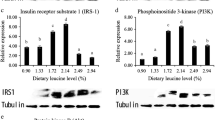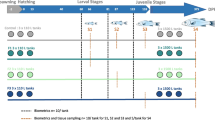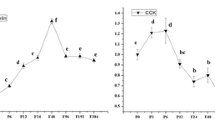Abstract
An emerging concept is that the hypothalamic nutrient sensor can regulate peripheral energy metabolism via a brain-liver circuit. Valine is an essential branched-chain amino acid (BCAA) that drives intracellular signaling cascades by the activation of target of rapamycin complex 1 (TORC1) which is critical to protein metabolism in mammals. However, in teleost fish, it remains scarce in this area especially about how the intraventricular (ICV) injection of valine can mediate the protein metabolism in peripheral organs. This study would tentatively explore the effects of ICV injection of valine on protein metabolism in peripheral organs through evaluating the postprandial ammonia-N excretion rate in Chinese perch. The control group was injected with 5-μL PBS, and the Val group was injected with 20-μg L valine dissolved into 5-μL PBS. The ammonia-N excretion rate of Val group was lower than control group at 4-, 12-, and 24-h postinjection, while the concertation of plasma glucose was increased sharply at 0.5-, 4-, 12-, and 24-h postinjection. We further checked both mRNA level and the enzyme activity of glutamate dehydrogenase (GDH) in the liver and adenosine monophosphate deaminase (AMPD) in muscle, and we found that they were obviously decreased in Val group at 4-, 12-, and 24-h postinjection. The phosphorylation level of ribosomal protein S6, a downstream target protein of TORC1, was markedly enhanced in the liver of Val group at 4-, 12-, and 24-h postinjection. Collectively, these results illustrated that ICV injection of valine can attenuate protein degradation in peripheral organs by depressing the GDH and AMPD enzyme activity; on the other hand, the injected valine can trigger the activation of TORC1 in the liver via a brain-liver circuit and then interdict proteolysis.





Similar content being viewed by others
Abbreviations
- BCAAs:
-
Branched-chain amino acids
- TORC1:
-
Target of rapamycin complex 1
- ICV:
-
Intraventricular
- GDH:
-
Glutamate dehydrogenase
- AMPD:
-
Adenosine monophosphate deaminase
- rpS6:
-
Ribosomal protein S6
- CNS:
-
Central nervous system
- Leu:
-
Leucine
- Val:
-
Valine
- Ile:
-
Isoleucine
- PBS:
-
Phosphate buffer solution
- αKG:
-
Alpha-ketoglutarate
- AMP:
-
Adenosine monophosphate
- IMP:
-
Inosine monophosphate
References
Ahmed I, Khan MA (2006) Dietary branched-chain amino acid valine, isoleucine and leucine requirements of fingerling Indian major carp, Cirrhinus mrigala (Hamilton). Br J Nutr 96:450–460
Anthony JC, Yoshizawa F, Anthony TG, Vary TC, Jefferson LS, Kimball SR (2000) Leucine stimulates translation initiation in skeletal muscle of postabsorptive rats via a rapamycin-sensitive pathway. J Nutr 130:2413–2419
Appuhamy JA, Knoebel NA, Nayananjalie WA, Escobar J, Hanigan MD (2012) Isoleucine and leucine independently regulate mTOR signaling and protein synthesis in MAC-T cells and bovine mammary tissue slices. J Nutr 142:484–491
Ballestrazzi R, Lanari D, Dagaro E, Mion A (1994) The effect of dietary-protein level and source on growth, body-composition, total ammonia and reactive phosphate excretion of growing sea bass (Dicentrarchus-Labrax). Aquaculture 127:197–206
Belghit I, Skiba-Cassy S, Geurden I, Dias K, Surget A, Kaushik S, Panserat S, Seiliez I (2014) Dietary methionine availability affects the main factors involved in muscle protein turnover in rainbow trout (Oncorhynchus mykiss). Br J Nutr 112:493–503
Blouet C, Schwartz GJ (2010) Hypothalamic nutrient sensing in the control of energy homeostasis. Behav Brain Res 209:1–12
Blouet C, Jo YH, Li X, Schwartz GJ (2009) Mediobasal hypothalamic leucine sensing regulates food intake through activation of a hypothalamus-brainstem circuit. J Neurosci 29:8302–8311
Brett JR, Zala CA (1975a) Daily pattern of nitrogen excretion and oxygen-consumption of sockeye salmon (Oncorhynchus-Nerka) under controlled conditions. J Fish Res Board Can 32:2479–2486
Brett JR, Zala CA (1975b) Daily pattern of nitrogen excretion and oxygen consumption of sockeye Salmon (Oncorhynchus nerka) under controlled conditions. J Fish Res Board Can 32:2479–2486
Cai YJ, Summerfelt RC (1992) Effects of temperature and size on oxygen-consumption and ammonia excretion by walleye. Aquaculture 104:127–138
Chen L-q, Hu Y (2011) Influencing factors on determination of ammonia nitrogen in water by nessler's reagent spectrophotometry. 1173–1176
Choi YH, Fletcher PJ, Anderson GH (2001) Extracellular amino acid profiles in the paraventricular nucleus of the rat hypothalamus are influenced by diet composition. Brain Res 892:320–328
Cota D, Proulx K, Smith KA, Kozma SC, Thomas G, Woods SC, Seeley RJ (2006) Hypothalamic mTOR signaling regulates food intake. Science 312:927–930
Cowey CB (1995) Intermediary metabolism in fish with reference to output of end-products of nitrogen and phosphorus. Water Sci Technol 31:21–28
De Pedro N, Pinillos ML, Valenciano AI, Alonso-Bedate M, Delgado MJ (1998) Inhibitory effect of serotonin on feeding behavior in goldfish: involvement of CRF. Peptides 19:505–511
Dodd KM, Tee AR (2012) Leucine and mTORC1: a complex relationship. Am J Physiol Endocrinol Metab 302:E1329–E1342
Duran RV, Oppliger W, Robitaille AM, Heiserich L, Skendaj R, Gottlieb E, Hall MN (2012) Glutaminolysis activates rag-mTORC1 signaling. Mol Cell 47:349–358
Everaert N, Swennen Q, Coustard SM, Willemsen H, Careghi C, Buyse J, Bruggeman V, Decuypere E, Tesseraud S (2010) The effect of the protein level in a pre-starter diet on the post-hatch performance and activation of ribosomal protein S6 kinase in muscle of neonatal broilers. Br J Nutr 103:206–211
Fang L, Bai X-L, Liang X-F, He S, Guo X-Z, Li L, Li B, Shen D, Tao Y-X (2017) Ammonia nitrogen excretion in mandarin fish (Siniperca chuatsi) and grass carp (Ctenopharyngodon idellus) fed practical diets: the effects of water temperature. Aquac Res 48:836–843
Fernstrom JD (2005) Branched-chain amino acids and brain function. J Nutr 135:1539S–1546S
Forsberg JA, Summerfelt RC (1992) Effect of temperature on diel ammonia excretion of fingerling walleye. Aquaculture 102:115–126
Fournier V, Gouillou-Coustans MF, Métailler R, Vachot C, Moriceau J, Le Delliou H, Huelvan C, Desbruyeres E, Kaushik SJ (2003) Excess dietary arginine affects urea excretion but does not improve N utilisation in rainbow trout Oncorhynchus mykiss and turbot Psetta maxima. Aquaculture 217:559–576
Freund HR, James JH, Fischer JE (1981) Nitrogen-sparing mechanisms of singly administered branched-chain amino acids in the injured rat. Surgery 90:237–243
Frigerio F, Casimir M, Carobbio S, Maechler P (2008) Tissue specificity of mitochondrial glutamate pathways and the control of metabolic homeostasis. Biochim Biophys Acta 1777:965–972
Gowen RJ (1994) Managing eutrophication associated with aquaculture development. J Appl Ichthyol 10:242–257
Guroy D, Sahin I, Guroy B, Altin A, Merrifield DL (2012) Effect of dietary protein level on growth performance and nitrogen excretion of the yellow tail cichlid, Pseudotropheus acei. Isr J Aquacult-Bamid 64
He S, Liang XF, Sun J, Li L, Yu Y, Huang W, Qu CM, Cao L, Bai XL, Tao YX (2013) Insights into food preference in hybrid F1 of Siniperca chuatsi (female symbol) x Siniperca scherzeri (male symbol) mandarin fish through transcriptome analysis. BMC Genomics 14:601
Holecek M (2002) Relation between glutamine, branched-chain amino acids, and protein metabolism. Nutrition 18:130–133
Hutson SM, Harris RA (2001) Introduction. Symposium: leucine as a nutritional signal. J Nutr 131:839S–840S
Izumi T, Kawamura K, Ueda H, Bungo T (2004) Central administration of leucine, but not isoleucine and valine, stimulates feeding behavior in neonatal chicks. Neurosci Lett 354:166–168
Kimball SR, Jefferson LS (2002) Control of protein synthesis by amino acid availability. Curr Opin Clin Nutr 5:63–67
Kimball SR, Jefferson LS (2006) Signaling pathways and molecular mechanisms through which branched-chain amino acids mediate translational control of protein synthesis. J Nutr 136:227S–231S
Kimball SR, Shantz LM, Horetsky RL, Jefferson LS (1999) Leucine regulates translation of specific mRNAs in L6 myoblasts through mTOR-mediated changes in availability of eIF4E and phosphorylation of ribosomal protein S6. J Biol Chem 274:11647–11652
Kutty MN (1978) Ammonia quotient in sockeye salmon (Oncorhynchus-Nerka). J Fish Res Board Can 35:1003–1005
Lang CH, Frost RA, Bronson SK, Lynch CJ, Vary TC (2010) Skeletal muscle protein balance in mTOR heterozygous mice in response to inflammation and leucine. Am J Physiol Endocrinol Metab 298:E1283–E1294
Lazutkaite G, Solda A, Lossow K, Meyerhof W, Dale N (2017) Amino acid sensing in hypothalamic tanycytes via umami taste receptors. Mol Metab 6:1480–1492
Leung KMY, Chu JCW, Wu RSS (1999) Interacting effects of water temperature and dietary protein levels on post-prandial ammonia excretion by the areolated grouper Epinephelus areolatus (Forskal). Aquac Res 30:793–798
Li M, Li C, Allen A, Stanley CA, Smith TJ (2012) The structure and allosteric regulation of mammalian glutamate dehydrogenase. Arch Biochem Biophys 519:69–80
Liang XF, Oku H, Ogata HY, Liu J, He X (2001) Weaning Chinese perch Siniperca chuatsi (Basilewsky) onto artificial diets based upon its specific sensory modality in feeding. Aquac Res 32:76–82
Liu Z, Zhou Y, Liu S, Zhong H, Zhang C, Kang X, Liu Y (2012) Characterization and dietary regulation of glutamate dehydrogenase in different ploidy fishes. Amino Acids 43:2339–2348
Livak KJ, Schmittgen TD (2001) Analysis of relative gene expression data using real-time quantitative PCR and the 2(−Delta Delta C(T)) method. Methods 25:402–408
Lushchak VI, Husak VV, Storey JM, Storey KB (2009) AMP-deaminase from goldfish white muscle: regulatory properties and redistribution under exposure to high environmental oxygen level. Fish Physiol Biochem 35:443–452
Lynch CJ, Adams SH (2014) Branched-chain amino acids in metabolic signalling and insulin resistance. Nat Rev Endocrinol 10:723–736
McCormack SE, Shaham O, McCarthy MA, Deik AA, Wang TJ, Gerszten RE, Clish CB, Mootha VK, Grinspoon SK, Fleischman A (2013) Circulating branched-chain amino acid concentrations are associated with obesity and future insulin resistance in children and adolescents. Pediatr Obes 8:52–61
Meijer AJ, Dubbelhuis PF (2004) Amino acid signalling and the integration of metabolism. Biochem Biophys Res Commun 313:397–403
Morisaki T, Gross M, Morisaki H, Pongratz D, Zollner N, Holmes EW (1992) Molecular basis of AMP deaminase deficiency in skeletal muscle. Proc Natl Acad Sci U S A 89:6457–6461
Morrison CD, Xi X, White CL, Ye J, Martin RJ (2007) Amino acids inhibit Agrp gene expression via an mTOR-dependent mechanism. Am J Physiol Endocrinol Metab 293:E165–E171
Newgard CB, An J, Bain JR, Muehlbauer MJ, Stevens RD, Lien LF, Haqq AM, Shah SH, Arlotto M, Slentz CA, Rochon J, Gallup D, Ilkayeva O, Wenner BR, Yancy WS Jr, Eisenson H, Musante G, Surwit RS, Millington DS, Butler MD, Svetkey LP (2009) A branched-chain amino acid-related metabolic signature that differentiates obese and lean humans and contributes to insulin resistance. Cell Metab 9:311–326
O'Hare JD, Zsombok A (2016) Brain-liver connections: role of the preautonomic PVN neurons. Am J Physiol Endocrinol Metab 310:E183–E189
Ortega VA, Lovejoy DA, Bernier NJ (2013) Appetite-suppressing effects and interactions of centrally administered corticotropin-releasing factor, urotensin I and serotonin in rainbow trout (Oncorhynchus mykiss). Front Neurosci 7:196
Paulson LJ (1980) Models of ammonia excretion for brook trout (Salvelinus fontinalis) and rainbow trout (Salmo gairdneri). Can J Fish Aquat Sci 37:1421–1425
Peres H, Oliva-Teles A (2007) Effect of the dietary essential amino acid pattern on growth, feed utilization and nitrogen metabolism of European sea bass (Dicentrarchus labrax). Aquaculture 267:119–128
Peres H, Oliva-Teles A (2008) Lysine requirement and efficiency of lysine utilization in turbot (Scophthalmus maximus) juveniles. Aquaculture 275:283–290
Pocai A, Obici S, Schwartz GJ, Rossetti L (2005) A brain-liver circuit regulates glucose homeostasis. Cell Metab 1:53–61
Rahimnejad S, Lee KJ (2013) Dietary valine requirement of juvenile red sea bream Pagrus major. Aquaculture 416:212–218
Sánchez MS, Barontini M, Armando I, Celis ME (2001) Correlation of increased grooming behavior and motor activity with alterations in nigrostriatal and mesolimbic catecholamines after α-melanotropin and neuropeptide glutamine–isoleucine injection in the rat ventral tegmental area. Cell Mol Neurobiol 21:523–533
Shao D, Villet O, Zhang Z, Choi SW, Yan J, Ritterhoff J, Gu H, Djukovic D, Christodoulou D, Kolwicz SC Jr et al (2018) Glucose promotes cell growth by suppressing branched-chain amino acid degradation. Nat Commun 9:2935
Shimomura Y, Yamamoto Y, Bajotto G, Sato J, Murakami T, Shimomura N, Kobayashi H, Mawatari K (2006) Nutraceutical effects of branched-chain amino acids on skeletal muscle. J Nutr 136:529S–532S
Smith QR (2000) Transport of glutamate and other amino acids at the blood-brain barrier. J Nutr 130:1016S–1022S
Strebkova TP, Shabalina VN (1984) Farming of Chinese perch[J]. Mar Fish Cult:41–52
Su Y, Lam TK, He W, Pocai A, Bryan J, Aguilar-Bryan L, Gutierrez-Juarez R (2012) Hypothalamic leucine metabolism regulates liver glucose production. Diabetes 61:85–93
Swaab DF, Hofman MA, Lucassen PJ, Purba JS, Raadsheer FC, Van de Nes JA (1993) Functional neuroanatomy and neuropathology of the human hypothalamus. Anat Embryol (Berl) 187:317–330
Vandenberghe G, Bontemps F, Vincent MF, Vandenbergh F (1992) The purine nucleotide cycle and its molecular defects. Prog Neurobiol 39:547–561
Vandesompele J, De Preter K, Pattyn F, Poppe B, Van Roy N, De Paepe A, Speleman F (2002) Accurate normalization of real-time quantitative RT-PCR data by geometric averaging of multiple internal control genes. Genome Biol 3:RESEARCH0034
Vary TC, Lynch CJ (2007) Nutrient signaling components controlling protein synthesis in striated muscle. J Nutr 137:1835–1843
Walton MJ, Cowey CB (1977) Aspects of Ammoniogenesis in rainbow-trout, Salmo-Gairdneri. Comp Biochem Physiol B 57:143–149
Wang X, Proud CG (2006) The mTOR pathway in the control of protein synthesis. Physiology (Bethesda) 21:362–369
Wang PY, Caspi L, Lam CK, Chari M, Li X, Light PE, Gutierrez-Juarez R, Ang M, Schwartz GJ, Lam TK (2008) Upper intestinal lipids trigger a gut-brain-liver axis to regulate glucose production. Nature 452:1012–1016
Wang Q, He G, Mai K, Xu W, Zhou H (2016a) Fishmeal replacement by mixed plant proteins and maggot meal on growth performance, target of rapamycin signalling and metabolism in juvenile turbot (Scophthalmus maximus L.). Aquac Nutr 22:752–758
Wang Q, He G, Mai K, Xu W, Zhou H, Wang X, Mei L (2016b) Chronic rapamycin treatment on the nutrient utilization and metabolism of juvenile turbot (Psetta maxima). Sci Rep 6:28068
Wang J, Liang XF, He S, Li J, Huang K, Zhang YP, Huang D (2018) Lipid deposition pattern and adaptive strategy in response to dietary fat in Chinese perch (Siniperca chuatsi). Nutr Metab (Lond) 15:77
Wu RSS (1995) The environmental impact of marine fish culture: towards a sustainable future. Mar Pollut Bull 31:159–166
Yang SD, Liou CH, Liu FG (2002) Effects of dietary protein level on growth performance, carcass composition and ammonia excretion in juvenile silver perch (Bidyanus bidyanus). Aquaculture 213:363–372
Yigit M, Yardim O, Koshio S (2002) The protein sparing effects of high lipid levels in diets for rainbow trout (Oncorhynchus mykiss, W. 1792) with special reference to reduction of total nitrogen excretion. Isr J Aquacult-Bamid 54:79–88
Yigit M, Koshio S, Aral O, Karaali B, Karayucel S (2003) Ammonia nitrogen excretion rate - An index for evaluating protein quality of three feed fishes for the black sea turbot. Isr J Aquacult-Bamid 55:69–76
Yoshizawa F (2004) Regulation of protein synthesis by branched-chain amino acids in vivo. Biochem Biophys Res Commun 313:417–422
Zheng ZM, Jin CH, Li MY, Bai PF, Dong SL (2008) Effects of temperature and salinity on oxygen consumption and ammonia excretion of juvenile miiuy croaker, Miichthys miiuy (Basilewsky). Aquac Int 16:581–589
Funding
This work was financially supported by the China Agriculture Research System (CARS-46), National Key R&D Program of China (2018YFD0900400) and Da Bei Nong Group Promoted Project for Young Scholar of HZAU (No. 2017DBN014).
Author information
Authors and Affiliations
Contributions
Conceived and designed the experiments: JW, XFL, SH, and JL.
Carried out the experiments: JW, KH, YPZ, LJS, and PR.
Analyzed all the data: JW, KH, YPZ, LJS, and PR.
Wrote and revised the manuscript: JW.
All authors read and approved the final manuscript.
Corresponding author
Ethics declarations
Conflict of interest
The authors declare that they have no comflict of interest.
Additional information
Publisher’s note
Springer Nature remains neutral with regard to jurisdictional claims in published maps and institutional affiliations.
Rights and permissions
About this article
Cite this article
Wang, J., Liang, XF., He, S. et al. Valine acts as a nutritional signal in brain to activate TORC1 and attenuate postprandial ammonia-N excretion in Chinese perch (Siniperca chuatsi). Fish Physiol Biochem 46, 2015–2025 (2020). https://doi.org/10.1007/s10695-020-00767-y
Received:
Accepted:
Published:
Issue Date:
DOI: https://doi.org/10.1007/s10695-020-00767-y




